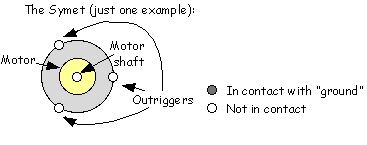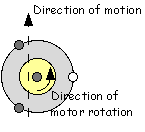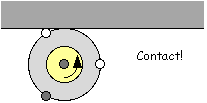|
|
|
|
The BEAM Bestiary is a BEAM Reference Library site.
Symets
So called, because they're
SYMmETrical
Symets are the ultimate in producing elegant behaviors from simple mechanical and electrical designs -- they make use of their symmetry to produce obstacle-avoiding behavior with a single motor and no sensors.
The basic idea is that a Symet scoots along a flat surface (table, etc.) on the tip of its motor shaft, and on 2 "outriggers" (remember that it only takes 3 points to define a plane, so a motor shaft and 2 "outriggers" will be stable on a flat surface). In most Symet designs, the "outriggers" are capacitors that are part of the Symet's electronics, although other structural elements can also do the job. Symets avoid obstacles by having 3 or more "outriggers" -- when the Symet butts up against a wall or other obstacle, it tips onto different "outriggers," thus altering its subsequent path away from (or at least parallel to) the obstacle.
This is easier to see with an example. Let's look at a Trimet (trilateral Symet):
|
|
|
|
|
|
|
|
|
|
|
F.J. Tragauer (SunBEAM) has a "step by step"
tutorial on Symets here. |
|
|
||
|
This page was last updated on |
|
|

 Set
it on a flat surface, and our Symet scoots along
comfortably:
Set
it on a flat surface, and our Symet scoots along
comfortably: When
it contacts an obstacle, the Symet (if you built it
correctly) starts to tip:
When
it contacts an obstacle, the Symet (if you built it
correctly) starts to tip: Once
it has tipped onto another set of "outriggers," the
Symet will now be moving away from the
obstacle:
Once
it has tipped onto another set of "outriggers," the
Symet will now be moving away from the
obstacle: